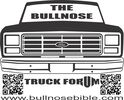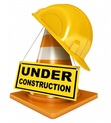engine swaps
One of the frequent questions that arise is about swapping another engine into one of these trucks. And, with the number of engines Ford put into them as well as the differences between the engines, there are a number of things to consider:
- Engine stands: Also called perches or brackets, the engine stands are bolted and/or riveted to the frame. This is covered in detail on the page called Engine Perches/Stands/Brackets, but generally there are different stands for each of these engine lines, so if you are converting from one engine line to another you'll have to change out the stands:
- 3.8L V6
- 300 in-line six
- 255, 302, and 351W
- 351M & 400
- 460
- Diesel
- Oil Pan: The engines in these trucks have to have a rear-sump oil pan. But, most Ford cars had front-sump oil pans. So, if you are swapping an engine from a car into a truck you'll need a rear-sump pan as well as the longer oil pickup and main-bolt stud that holds the pickup.
- Transmission: For the engines used in these trucks there were 3 bell housing bolt patterns, and transmissions from one pattern will not work with an engine from another pattern w/o adaptation:
- Small-block pattern: This pattern includes the 3.8L V6, the 300 in-line six, and the 255, 302, and 351W V8's
- Big-block pattern: The 351M, 400, and 460 share this pattern. However, the flywheel on the 460 sits ~.5" further aft of the block than those of the M-block, so which the transmission will bolt up that does not mean it'll work. (See Dad's Transmission for a discussion of how to bolt a 460's ZF5 to an M-block.)
- Diesel: These engines had a different pattern from any of the gas engines.
- Flywheels: Each engine series had its own flywheels, and even within the series there were differences. So, the flywheel from a 300 six won't work with a 302. In fact, there were two very different flywheels w/in the 302's. And, there were different flywheels, or flexplates, between the different automatic transmissions. So, see the flywheel section for details. However, note that there is a flywheel/flexplate for a C4, a different one for a C5 & AOD, and one for the C6 - and they do not interchange.
- Torque converters:
- Radiator: The 300 six radiator is the odd one out here as its inlet and outlet are swapped from all of the other engines. But, the radiators for the V engines are similar enough that you can usually re-use the old radiator - if it has enough cooling capacity.
- Exhaust system: Obviously an in-line engine has a different exhaust system than a V8, but there's a lot of variation w/in the V8 line as well since 255's and 302's are narrower than 351W's so their Y-pipes are different. The 351M and 400's are the same block as each other so take the same exhaust. The 460's are quite wide and the diesel engines are very different from the gas engines. So, basically if you swap from one engine series to another you will have to change out at least part of the exhaust system.
- Throttle cable:
- Fuel line:
- Wiring: All of the gas engines have roughly the same basic electrical requirements, so the engine wiring harnesses between different engines with the same ignition systems are electrically the same. However, the alternators and sending units are in differing locations so the length of each wire may be quite different between the harnesses for different engines. For instance, the oil pressure sending unit on a 351M or 400 is at the rear on top, but on a 351W its by the fuel pump, down low. So, the wire to the oil pressure sending unit is a lot longer on an M than a W. In other words, if you don't use the harness for the engine you are swapping to then you are very likely to have to adjust the length of the wires going to various things. In addition, the wiring harnesses for an 8 cylinder engine has a ground to tell the tach to count 4 pulses per revolution, where the 6 cylinder harnesses don't have the ground so the tach counts 3 pulses per revolution.
- Springs: There is a wide range of weights between engines, and Ford put the correct springs in the truck to make it work with the engine it came with. So, if you are changing engines you'll want to consider changing out the springs. Here are the stock engine weights as best I can tell from Kelly Hotrod for the V-engine info, and BlueOvalTrucks for the diesel info.
- 3.8L V6: 402 lbs
- 300 in-line six
- 255 (460), 302 (460), and 351W (525)
- 351M & 400: 575 lbs
- 460: 720 lbs
- Diesel: 860 lbs

